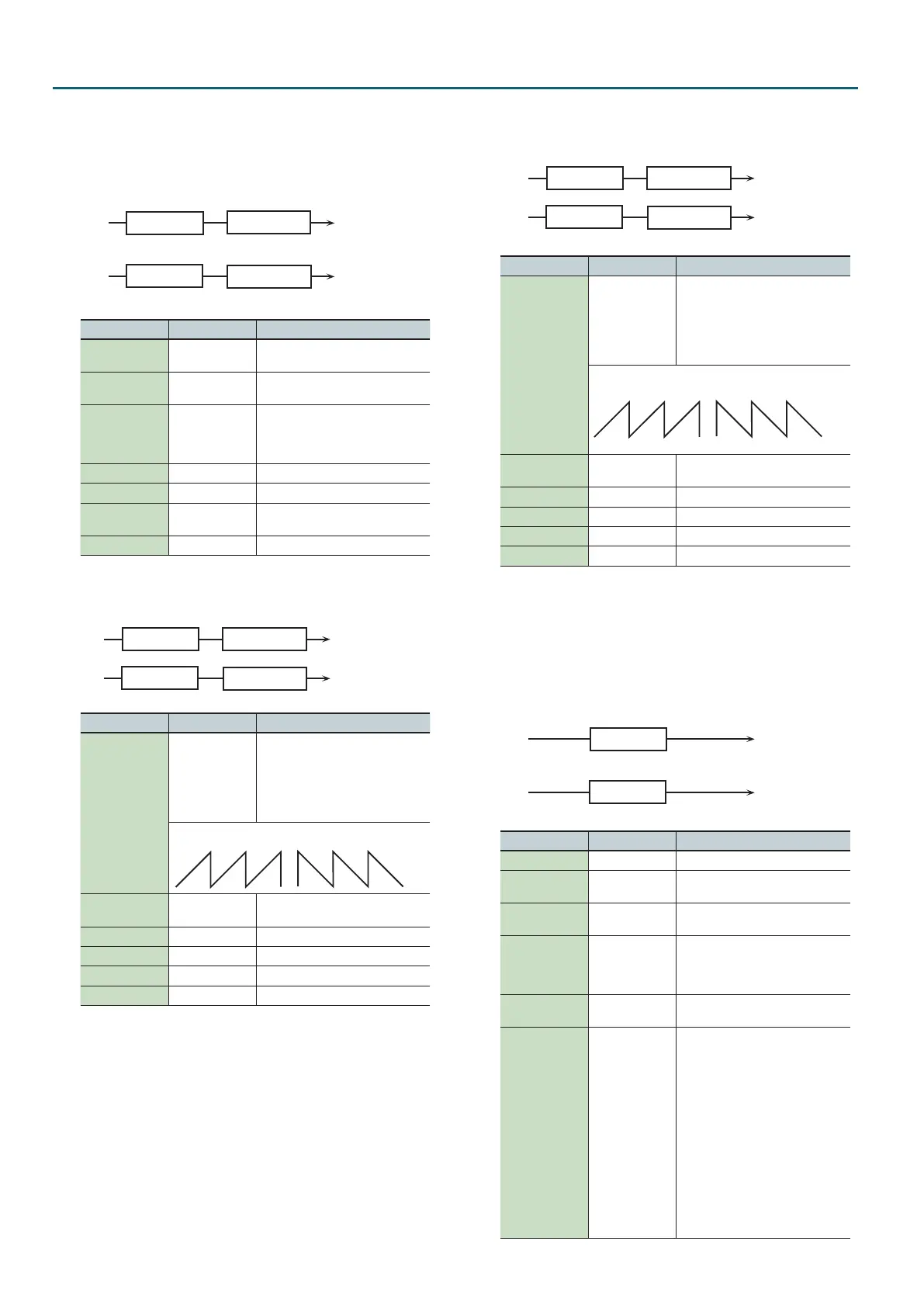78
MFX Parameters
15: Ring Modulator
This is an eect that applies amplitude modulation (AM) to the
input signal, producing bell-like sounds. You can also change the
modulation frequency in response to changes in the volume of the
sound sent into the eect.
L in
R in
L out
R out
Ring Mod
2-Band EQ
2-Band EQ
Ring Mod
Parameter Value Explanation
Frequency # 0–127
Adjusts the frequency at which
modulation is applied.
Sens # 0–127
Adjusts the amount of frequency
modulation applied.
Polarity UP, DOWN
Determines whether the frequency
modulation moves towards
higher frequencies (UP) or lower
frequencies (DOWN).
Low Gain -15–+15 dB Gain of the low frequency range
High Gain -15–+15 dB Gain of the high frequency range
Balance #
D100:0W
–D0:100W
Volume balance between the direct
sound (D) and the eect sound (W)
Level 0–127 Output level
16: Tremolo
Cyclically modulates the volume to add tremolo eect to the sound.
L in
R in
L out
R out
Tremolo
2-Band EQ
2-Band EQ
Tremolo
Parameter Value Explanation
Mod Wave
TRI, SQR, SIN,
SAW1, SAW2
Modulation Wave
TRI: triangle wave
SQR: square wave
SIN: sine wave
SAW1/2: sawtooth wave
SAW1 SAW2
Rate #
0.05–10.00 Hz,
note
Frequency of the change
Depth # 0–127 Depth to which the eect is applied
Low Gain -15–+15 dB Gain of the low range
High Gain -15–+15 dB Gain of the high range
Level 0–127 Output Level
17: Auto Pan
Cyclically modulates the stereo location of the sound.
L in
R in
L out
R out
Auto Pan
2-Band EQ
2-Band EQ
Auto Pan
Parameter Value Explanation
Mod Wave
TRI, SQR, SIN,
SAW1, SAW2
Modulation Wave
TRI: triangle wave
SQR: square wave
SIN: sine wave
SAW1/2: sawtooth wave
SAW1 SAW2
R R
L L
Rate #
0.05–10.00 Hz,
note
Frequency of the change
Depth # 0–127 Depth to which the eect is applied
Low Gain -15–+15 dB Gain of the low range
High Gain -15–+15 dB Gain of the high range
Level 0–127 Output Level
18: Slicer
By applying successive cuts to the sound, this eect turns a
conventional sound into a sound that appears to be played as a
backing phrase. This is especially eective when applied to sustain-
type sounds.
You can use MFX CONTROL to restart the step sequence from the
beginning (p. 97).
L in
R in
L out
R out
Slicer
Slicer
Parameter Value Explanation
Step 01–16 L64 –63R Level at each step
Rate #
0.05 –10.00 Hz,
note
Rate at which the 16-step sequence
will cycle
Attack # 0–127
Speed at which the level changes
between steps
Input Sync Sw OFF, ON
Species whether an input note will
cause the sequence to resume from
the rst step of the sequence (ON)
or not (OFF)
Input Sync
Threshold
0–127
Volume at which an input note will
be detected
Mode LEGATO, SLASH
Sets the manner in which the
volume changes as one step
progresses to the next.
LEGATO: The change in volume
from one step’s level to the next
remains unaltered. If the level of a
following step is the same as the one
preceding it, there is no change in
volume.
SLASH: The level is momentarily
set to 0 before progressing to the
level of the next step. This change
in volume occurs even if the level of
the following step is the same as the
preceding step.

